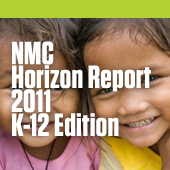 While learning analytics has potential for innovation in teaching, personal learning environments, also on the New Media Consortium’s four to five year horizon, place the emphasis on what learners themselves might control.
While learning analytics has potential for innovation in teaching, personal learning environments, also on the New Media Consortium’s four to five year horizon, place the emphasis on what learners themselves might control.
In concept, personal learning environments would encourage students to approach learning in ways best suited to their individual needs. Visual learners, for example, might be able to obtain material from a different source than auditory learners. Students using PLEs may further benefit from the practice of keeping track of, and curating, their own resource collections. Personal learning environments are seen as a way to shift the control over learning — particularly its pace, style, and direction — to the learner. The NMC Horizon Report: 2011 K-12 page 31
While it is not difficult to see how personal learning environments might be used to help students become more independent, some discussion of the benefits rests on questionable assumptions; for example, the validity of learning styles as a differentiator. Research now throws significant doubt on the usefulness of the learning styles concept. A useful summary of the difficulties can be found on page 11 of the Demos Report, About Learning.
Calling into question the usefulness of ‘learning styles’ as an organiser, does not invalidate the usefulness of personal learning environments .The growing body of research on cognitive brain function could better inform and develop the technologies around personal learning environments. If information derived from an individual’s genetic profile, brain structure and chemistry were able to be matched with some of the learning patterning emerging from learning analytics, it might be possible to validate, amend or eliminate some current assumptions and design useful, specific learning programs.
Neuroscientific research has shown that London cab drivers’ brains adapt to reflect the patterns of their frequent behaviour; i.e. navigating around routes and traffic. As these synaptic transfers adapt, the structure of the brain changes; the corpus callosum becomes a more dominant presence and shifts how the brain cognates. In other words, the more London cab drivers whip round different routes the more effective and quicker they become at on-demand-cognitive-navigation; they’re building up a particular kind of muscle memory, sub-consciously, as a direct response to their daily practices. A kind of Descartian-Dualism perhaps.
However, give a Cabbie a paper map and he’ll take a lot longer to get you where you want to go. The neurological shift caused by repeated behaviours, permanently impacts the way that the brain works. Simply put; “Muscle Memory”. …Our challenge is that this is out of sync with traditional pedagogy & practice; teaching & learning, concepts of schooling and education.
It is when students and teachers have tools that incorporate the growing body of tested scientific knowledge relevant to learning that we might see teaching and learning that enables innovation on the scale seen in what Jim Bosco describes in his introduction to Kathryn Moyle’s, Building Innovation: Learning with Technologies, as the world of information, knowledge production and dissemination, and learning as it exists outside of the schools.